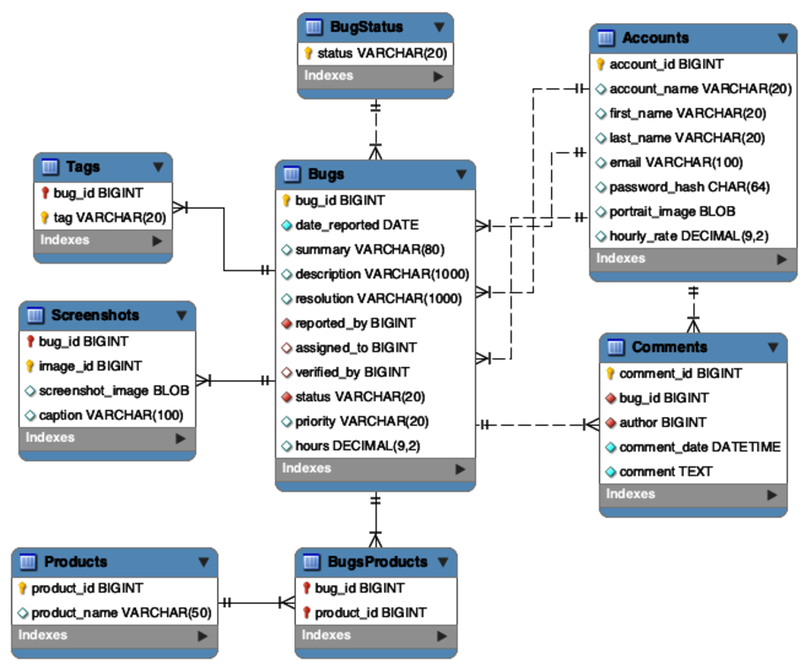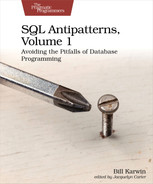Example Database
Most of the topics in SQL Antipatterns are illustrated using a database for a hypothetical bug-tracking application.
The following data definition language shows the tables defined in SQL. In some cases, choices are made for the sake of examples later in the book, so they might not always be the choices one would make in a real-world application. Examples use only standard SQL so they are applicable to any brand of database, but some MySQL data types also appear, such as SERIAL and BIGINT.
| | CREATE TABLE Accounts ( |
| | account_id SERIAL PRIMARY KEY, |
| | account_name VARCHAR(20), |
| | first_name VARCHAR(20), |
| | last_name VARCHAR(20), |
| | email VARCHAR(100), |
| | password_hash CHAR(64), |
| | portrait_image BLOB, |
| | hourly_rate NUMERIC(9,2) |
| | ); |
| | |
| | CREATE TABLE BugStatus ( |
| | status VARCHAR(20) PRIMARY KEY |
| | ); |
| | |
| | CREATE TABLE Bugs ( |
| | bug_id SERIAL PRIMARY KEY, |
| | date_reported DATE NOT NULL DEFAULT (CURDATE()), |
| | summary VARCHAR(80), |
| | description VARCHAR(1000), |
| | resolution VARCHAR(1000), |
| | reported_by BIGINT UNSIGNED NOT NULL, |
| | assigned_to BIGINT UNSIGNED, |
| | verified_by BIGINT UNSIGNED, |
| | status VARCHAR(20) NOT NULL DEFAULT 'NEW', |
| | priority VARCHAR(20), |
| | hours NUMERIC(9,2), |
| | FOREIGN KEY (reported_by) REFERENCES Accounts(account_id), |
| | FOREIGN KEY (assigned_to) REFERENCES Accounts(account_id), |
| | FOREIGN KEY (verified_by) REFERENCES Accounts(account_id), |
| | FOREIGN KEY (status) REFERENCES BugStatus(status) |
| | ); |
| | |
| | |
| | CREATE TABLE Comments ( |
| | comment_id SERIAL PRIMARY KEY, |
| | bug_id BIGINT UNSIGNED NOT NULL, |
| | author BIGINT UNSIGNED NOT NULL, |
| | comment_date DATETIME NOT NULL DEFAULT CURRENT_TIMESTAMP, |
| | comment TEXT NOT NULL, |
| | FOREIGN KEY (bug_id) REFERENCES Bugs(bug_id), |
| | FOREIGN KEY (author) REFERENCES Accounts(account_id) |
| | ); |
| | |
| | CREATE TABLE Screenshots ( |
| | bug_id BIGINT UNSIGNED NOT NULL, |
| | image_id BIGINT UNSIGNED NOT NULL, |
| | screenshot_image BLOB, |
| | caption VARCHAR(100), |
| | PRIMARY KEY (bug_id, image_id), |
| | FOREIGN KEY (bug_id) REFERENCES Bugs(bug_id) |
| | ); |
| | |
| | CREATE TABLE Tags ( |
| | bug_id BIGINT UNSIGNED NOT NULL, |
| | tag VARCHAR(20) NOT NULL, |
| | PRIMARY KEY (bug_id, tag), |
| | FOREIGN KEY (bug_id) REFERENCES Bugs(bug_id) |
| | ); |
| | |
| | CREATE TABLE Products ( |
| | product_id SERIAL PRIMARY KEY, |
| | product_name VARCHAR(50) |
| | ); |
| | |
| | CREATE TABLE BugsProducts( |
| | bug_id BIGINT UNSIGNED NOT NULL, |
| | product_id BIGINT UNSIGNED NOT NULL, |
| | PRIMARY KEY (bug_id, product_id), |
| | FOREIGN KEY (bug_id) REFERENCES Bugs(bug_id), |
| | FOREIGN KEY (product_id) REFERENCES Products(product_id) |
| | ); |
Here is the entity-relationship diagram for the example bug database:

In some chapters, especially those in Logical Database Design Antipatterns, different database definitions appear, either to exhibit an antipattern or to show an alternative solution that avoids the antipattern.
This chapter has introduced antipatterns and you now know their field marks. Next we’ll dive into studying each antipattern and the trouble they cause.
